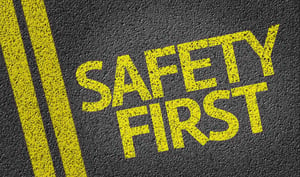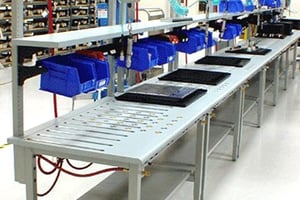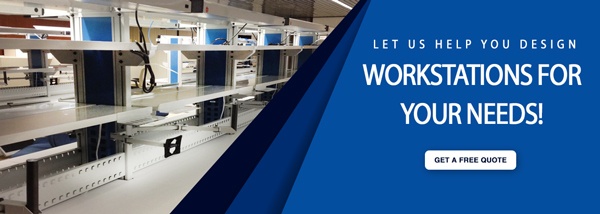Modular workstations are commonly used in today's office and industrial work environments. They provide flexibility and adjustability that can't be beat.
But one of the areas that businesses are forget to look at when they are setting up their workstations is reach zones. So let's take a look at what they are, why they are important and how you can incorporate accessories to make the best use of them.
The Importance of Ergonomic Design
 You've probably read about ergonomic design (hopefully right here on this blog), but you may not understand why it’s so important.
You've probably read about ergonomic design (hopefully right here on this blog), but you may not understand why it’s so important.
In a paper written by Quarterman Lee, P.E. & William Nelson (Strategos, Inc.), the human body is compared to a car. “In the human machine,” they write, “Muscles are both cylinders and pistons, and bones and joints are the gears. The muscles oxidize nutrients (fuel) and give up energy, while generating metabolic byproducts (waste).”
This analogy is meant to help us understand that our body too must be operated correctly – just as an automobile. If we jerk the wheel of our car, it will swerve off the road, if we back up too fast we may run into a curb.
Improper or repetitive movements of our human bodies can cause stress, pain, and even lead to serious injury...Tendonitis/ tenosynovitis, Epicondylitis (elbow tendonitis), Carpal tunnel syndrome, DeQuervain's disease, Thoracic outlet syndrome, and Tension neck syndrome are just a few of the conditions that can occur as a result of improper, repetitive, or strenuous movement.
Protecting employees from workplace injuries like those mentioned above is why Ergonomics have become such an important element in workplace design. To protect workers (including yourself) from some of the aforementioned conditions, reach zones should be taken into consideration.
An often overlooked group of employees are lab technicians using is laboratory workstations. They often encounter the same conditions as assembly line type conditions but are rarely seen as needing the same ergonomic equipment.
What Is An Ergonomic Reach Zone?
Let’s go back to the car analogy – cars have a specific range of motion like driving straight, turning left and right, and even going backwards. Just like cars, our bodies have their own predetermined range of motion and reach zones help us determine where this motion should take place.
For us humans, there are four horizontal and three vertical reach zones in which we could be moving.
- Zone 1 is sometimes referred to as the neutral reach zone or the optimal reach zone and is easily reached with a sweep of the forearm across the workspace. When working in zone 1 you should be able to keep your elbows close to your body and shoulders relaxed.
- Zone 2 is located just beyond arm’s length both horizontally and vertically.
- Zone 3 is the area you can reach with the arm stretched out from the body while bending at the waist and leaning your upper body forward or vertically more than 12” above shoulder height.
- Zone 4 only applies to the horizontal plane and is any spot greater than 44” away from your body.
It’s easy to see where it would require more effort and perhaps even joint or muscles strain in order to move within a zone. It’s also easy to see that some of our workplace tasks could take place in the more extreme zones if we don’t pre-plan.
Observe the posture, movement and motions a person makes when reaching for their work objects (whether it is a computer mouse or a roll of packaging tape) and then consider using modular workstations and add-on accessories to help prevent employees from completing work tasks outside of the appropriate zones.
How Modular Workstations and Accessories Promote Healthy Movement
 Modular workstations allow for easy changing of both the overall layout of the office and the individual components that make up a person’s individual work area. There are a variety of add-on accessories available that can prevent employees from completing tasks outside the neutral reach zones. Some examples of these accessories are:
Modular workstations allow for easy changing of both the overall layout of the office and the individual components that make up a person’s individual work area. There are a variety of add-on accessories available that can prevent employees from completing tasks outside the neutral reach zones. Some examples of these accessories are:
- Headsets: Prevents cradling of telephones between the ear and shoulder.
- Document holders: Keeps necessary files, folder, instructions and other items within easy reach
- Monitor Arms: Allows for easy movement of one, or multiple computer monitors in order to keep them at the correct eye level for different employees. A solution like this would be perfect for shared work spaces or lab stations, where different employees will be using the same equipment.
- Keyboard Trays: Ensures employees’ shoulders and wrists are in the correct reach zone when typing and using a mouse.
- Height Adjustable Surfaces: Enables employees of different heights can complete work within neutral reach zones.
- Shelving: Shelving attached to the workstation allows employees to have tools and parts close at hand
- Bins: Like shelving, bins allow employees to have tools and parts close at hand either on the worksurface or on a shelf.
- Drawers: Placed under the worksurface, they make it easy for employees to to access tools.
Summary
it’s important to remember that our bodies must be operated properly in order to keep running at optimum efficiency – just like a car. Incorporating workstation accessories into your industrial furniture and designs is just one way to keep employees safe, healthy and inside the proper reach zones.


